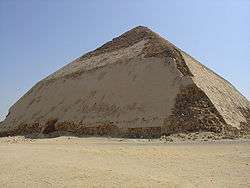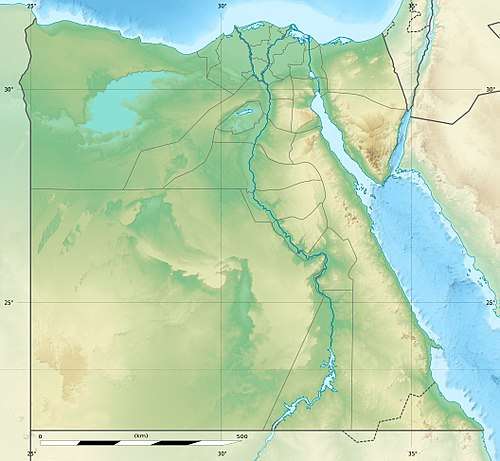Bent Pyramid
The Bent Pyramid is an ancient Egyptian pyramid located at the royal necropolis of Dahshur, approximately 40 kilometres south of Cairo, built under the Old Kingdom Pharaoh Sneferu (c. 2600 BC). A unique example of early pyramid development in Egypt, this was the second pyramid built by Sneferu.
| Bent Pyramid | |||||||||||||||||||||||||||||
|---|---|---|---|---|---|---|---|---|---|---|---|---|---|---|---|---|---|---|---|---|---|---|---|---|---|---|---|---|---|
 Sneferu's bent pyramid at Dahshur, an early experiment in true pyramid building | |||||||||||||||||||||||||||||
| Sneferu | |||||||||||||||||||||||||||||
| Coordinates | 29°47′25″N 31°12′33″E | ||||||||||||||||||||||||||||
| Ancient name | Ḫˁ Snfrw Kha Sneferu "Sneferu Shines"[1] "The Southern Shining Pyramid"[2] | ||||||||||||||||||||||||||||
| Constructed | c. 2600 BC (4th dynasty) | ||||||||||||||||||||||||||||
| Type | Bent Pyramid | ||||||||||||||||||||||||||||
| Material | Limestone | ||||||||||||||||||||||||||||
| Height | 104.71 metres (344 ft; 200 cu)[3] 47.04 metres (154 ft; 90 cu) beneath bend[3] 57.67 metres (189 ft; 110 cu) above bend[3] | ||||||||||||||||||||||||||||
| Base | 189.43 metres (621 ft; 362 cu) at base[3] 123.58 metres (405 ft; 236 cu) at bend[3] | ||||||||||||||||||||||||||||
| Volume | 1,237,040 cubic metres (43,685,655 cu ft)[2] | ||||||||||||||||||||||||||||
| Slope | 54°27′44″ below bend 43°22′ above bend[2] | ||||||||||||||||||||||||||||
 Location within Egypt | |||||||||||||||||||||||||||||
The Bent Pyramid rises from the desert at a 54-degree inclination, but the top section (above 47 metres) is built at the shallower angle of 43 degrees, lending the pyramid its very obvious 'bent' appearance.[4]
Overview
Archaeologists now believe that the Bent Pyramid represents a transitional form between step-sided and smooth-sided pyramids (see Step pyramid). It has been suggested that due to the steepness of the original angle of inclination the structure may have begun to show signs of instability during construction, forcing the builders to adopt a shallower angle to avert the structure's collapse.[5] This theory appears to be borne out by the fact that the adjacent Red Pyramid, built immediately afterwards by the same Pharaoh, was constructed at an angle of 43 degrees from its base. This fact also contradicts the theory that at the initial angle the construction would take too long because Sneferu's death was nearing, so the builders changed the angle to complete the construction in time. In 1974 Kurt Mendelssohn suggested the change of the angle to have been made as a security precaution in reaction to a catastrophic collapse of the Meidum Pyramid while it was still under construction.[6]

It is also unique amongst the approximately ninety pyramids to be found in Egypt, in that its original polished limestone outer casing remains largely intact. British structural engineer Peter James attributes this to larger clearances between the parts of the casing than used in later pyramids; these imperfections would work as expansion joints and prevent the successive destruction of the outer casing by thermal expansion.[7]
The ancient formal name of the Bent Pyramid is generally translated as (The)-Southern-Shining-Pyramid, or Sneferu-(is)-Shining-in-the-South. In July 2019, Egypt decided to open the Bent Pyramid for tourism for the first time since 1965.[8] Tourists will be able to reach two 4600-year-old chambers through a 79-metre narrow tunnel built from the northern entrance of the pyramid. The 18-metre-high "side pyramid", which is assumed to have been built for Sneferu's wife Hetepheres will also be accessible. It is the first time this adjacent pyramid has been opened to the public since its excavation in 1956.[9][10][11][12]

Interior passages
The Bent Pyramid has two entrances, one fairly low down on the north side, to which a substantial wooden stairway has been built for the convenience of tourists. The second entrance is high on the west face of the pyramid. Each entrance leads to a chamber with a high, corbelled roof; the northern entrance leads to a chamber that is below ground level, the western to a chamber built in the body of the pyramid itself. A hole in the roof of the northern chamber (accessed today by a high and rickety ladder 15 m (50 ft) long) leads via a rough connecting passage to the passage from the western entrance.
The western entrance passage is blocked by two stone blocks which were not lowered vertically, as in other pyramids, but slid down 45° ramps to block the passage. One of these was lowered in antiquity and a hole has been cut through it, the other remains propped up by a piece of ancient cedar wood. The connecting passage referenced above enters the passage between the two portcullises.
Pyramid temple
On the east side of the pyramid there are the fragmentary remains of the pyramid temple. Like the pyramid temple of the Meidum pyramid, there are two stelae behind the temple, though of these only stumps remain. There is no trace of inscription to be seen. The temple remains are fragmentary but it is presumed to be similar to that of the Meidum temple.
Satellite pyramid


A satellite pyramid, suggested by some Egyptologists to have been built to house the pharaoh's ka, is located 55 metres south of the Bent Pyramid.[13] The satellite pyramid originally measured 26 metres in height and 52.80 metres in length, with faces inclining 44°30'.[13][note 1] The structure is made of limestone blocks, relatively thick, arranged in horizontal rows and covered with a layer of fine limestone from Tura. The burial chamber is accessible from a descending corridor with its entrance located 1.10 metres above the ground in the middle of the north face.[13] The corridor, inclined at 34°, originally measured 11.60 metres in length.[13] A short horizontal passage connects the corridor with an ascending corridor, inclined at 32° 30', leading up to the chamber.[13]
The design of the corridors is similar to the one found in the Great Pyramid of Giza, where the Grand Gallery takes up the place of the ascending corridor. The corridor leads up to the burial chamber (called this despite that it most probably never contained any sarcophagus).[14] The chamber, located in the center of the pyramid, has a corbel vault ceiling and contains a four metres deep shaft, probably dug by treasure hunters, in the southeast part of the chamber.[14]
Like the main pyramid, the satellite had its own altar with two stelae located at the eastern side.[15]
Gallery
 The 11 degree change in angle
The 11 degree change in angle- Entrance to the Bent Pyramid
 View of the outer door inside the pyramid
View of the outer door inside the pyramid- Stairways inside the pyramid
- View towards the horizon
 Wooden beams in the pyramid
Wooden beams in the pyramid
See also
- List of Egyptian pyramids
- List of megalithic sites
Notes
- Nearly identical to the inclination of the Red Pyramid
Footnotes
- Verner 2001d, p. 174.
- Lehner 2008, p. 17.
- Verner 2001d, p. 462.
- Verner, Miroslav, The Pyramids - Their Archaeology and History, Atlantic Books, 2001, ISBN
- History Channel, Ancient Egypt - Part 3: Greatest Pharaohs 3150 to 1351 BC, History Channel, 1996, ISBN
- Mendelssohn, Kurt (1974), The Riddle of the Pyramids, London: Thames & Hudson
- James, Peter (May 2013). "New Theory on Egypt's Collapsing Pyramids". structuremag.org. National Council of Structural Engineers Associations. Retrieved 11 May 2013.
- "Egypt's Bent Pyramid opens to visitors". BBC News. 13 July 2019.
- Reuters (2019-07-14). "'Bent' pyramid: Egypt opens ancient oddity for tourism". The Guardian. ISSN 0261-3077. Retrieved 2019-07-15.
- "Egypt opens Sneferu's 'Bent' Pyramid in Dahshur to public". Reuters. 2019-07-13. Retrieved 2019-07-15.
- "Egyptian 'bent' pyramid dating back 4,600 years opens to public". The Independent. 2019-07-13. Retrieved 2019-07-15.
- "Egypt's 4,600yo Bent Pyramid opens to the public after more than half a century". ABC News. 2019-07-14. Retrieved 2019-07-15.
- Maragioglio & Rinaldi 1963, pp. 74–78
- A. Fakhry 1961
- Maragioglio & Rinaldi 1963, p. 80
References
- Fakhry, Ahmed (1961). The Monuments of Sneferu at Dahshur. General Organization for Government.CS1 maint: ref=harv (link)
- Lehner, Mark (2008). The Complete Pyramids. New York: Thames & Hudson. ISBN 978-0-500-28547-3.CS1 maint: ref=harv (link)
- Maragioglio, Vito & Rinaldi, Celeste (1963). L'Architettura delle Piramidi Menfite, parte III. Artale.CS1 maint: ref=harv (link)
- Verner, Miroslav (2001d). The Pyramids: The Mystery, Culture and Science of Egypt's Great Monuments. New York: Grove Press. ISBN 978-0-8021-1703-8.CS1 maint: ref=harv (link)
External links
| Wikimedia Commons has media related to Bent Pyramid. |
| Records | ||
|---|---|---|
| Preceded by Meidum |
World's tallest structure c. 2600 BCE – 2590 BCE 101 m |
Succeeded by Red Pyramid |